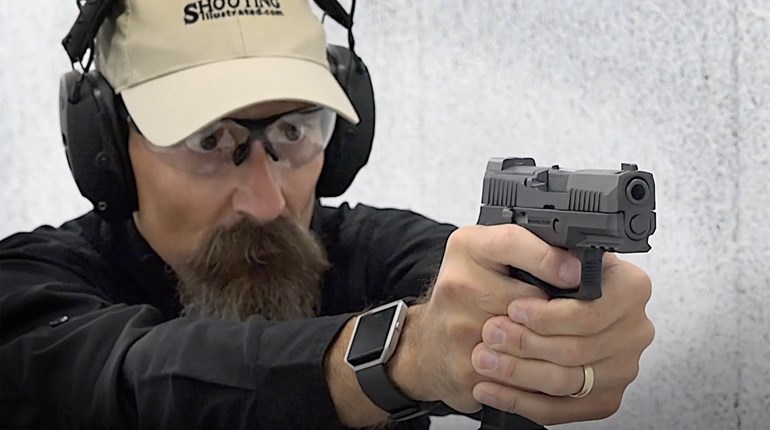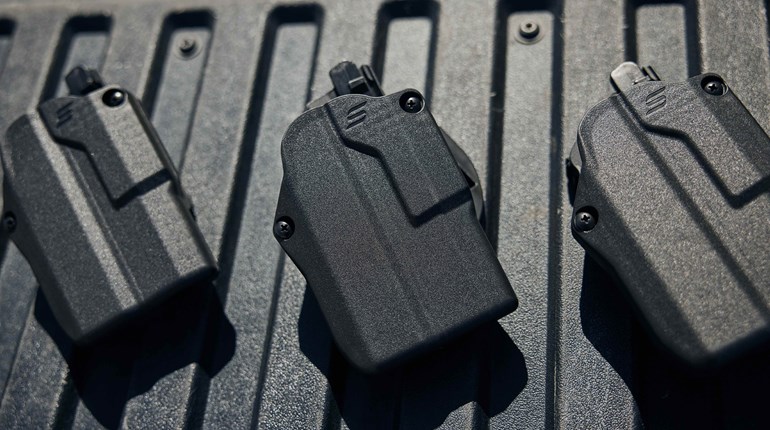
The FBI and other law enforcement entities have spoken. The time of the .40 has passed. Why? Simply put, the .40 over-promised and under-delivered.
When it came about (in large part because of the FBI), it was hailed as the wundercartridge. The origins came about in the 1970s, with Jeff Cooper of Guns & Ammo cheering on experimenters who developed what they ended up calling the .40 G&A. They built a Browning Hi-Power to shoot it, and the result was a 10-shot pistol that delivered a 180-grain bullet with a diameter of 4/10th of an inch at just over 1,000 feet per second (f.p.s.).
This was going to be “The Great Compromise.” Back then, the choice was either 9 mm or .45 ACP. And no one crossed sides. The 9 mm held lots of cartridges, but it wasn’t particularly accurate, and it didn’t do a good job of stopping a criminal. The.45 didn’t hold as many rounds, but it stopped a threat like a thrown brick—and it recoiled like it, as well.
The .40 was going to have the increased capacity like the 9 mm (or close enough), the stopping power of the .45 (or close enough) and a recoil that was in between.
What we got wasn’t any of that. The first problem was that the .40 was shoe-horned into 9mm-sized pistols. That increased the felt recoil and it cut down on capacity. Glock had an advantage here, as the company could fit 15 rounds of .40 into the same-size pistol that held 17 of the 9 mm Luger rounds. Everyone else, using 9 mm-sized magazine tubes, was limited to 11 or 12. That got changed a generation or two of pistol design later.
The standard ammunition—a 180-grain jacketed truncated cone (JTC) round—over-penetrated like nobody’s business. Worse than the 9 mm, in fact. How bad is penetration with the JTC in a .40? I have had opportunities to test ammunition in ballistic gelatin. Handgun blocks are 16 inches deep, rifle blocks 18 inches deep. I have yet to stop one when shooting into handgun blocks end-to-end. If I want a bullet, I have to drape an old vest on the back.
So, does the .40 have a future? Yes. For those who want more than a 9 mm, but not the .45, it fits the bill.
When the Detroit Police Department went to the Glock (it has since switched duty guns), regulations mandated full metal jacket (FMJ) ammunition. No one tested (or the higher-ups ignored) the possibility of over-penetration. After a few incidents, that changed. Going to jacketed hollow points (JHP) helped, but even those needed a bit more velocity than the under-1,000 f.p.s. of the 180-grain FMJ, and that increased the felt recoil. And going down in size, for an easy-to-carry EDC pistol, just made the recoil worse.
When Springfield Armory came out with its EMP, it was planned to be a 9 mm, .40 and .45 GAP pistol. I tested and wrote up the .40 version of it when it was new. Soon after, I was at a shooting shindig with Robbie Leatham, and I mentioned that I had just tested the EMP, and even tried some of the lightweight bullet loads, 135-grain screamers. “Those things hurt,” was his reply. When a professional shooter remarks that shooting a pistol his sponsor makes hurts, you know it was an unpleasant combination.
In 9 mm, the EMP is a grand little carry gun. So, as an every-day-carry pistol caliber, the .40 failed on everything it was supposed to deliver. Capacity wasn’t as much as we’d like (although it didn’t stay as bad as it had been in the earliest days). Recoil is more than the 9 mm. And if you want an improvement in stopping power, you have to get closer to that of the .45, like we were promised. It ended up being a .45 ACP lite.
So, does it have a future? Yes. For those who want more than a 9 mm, but not the .45, it fits the bill. A Glock is a good example here. A G22 offers a capacity that is two rounds fewer than that of the G17, and while it might recoil as hard as a .45, the G22 is not as bulky as the G21.
The .40 will also remain as a competition cartridge for quite some time. In USPSA/IPSC competition, the 9 mm is not permitted to shoot Major in some Divisions. In Open, yes, but not in any other Division. Competitors shooting in Limited will opt for the .40 over the .45 simply because of the extra magazine capacity. Once invested in .40 for Limited, they will most likely continue to use that cartridge in Limited 10 and Single Stack (Classic). The .45 will remain the caliber of choice for those who shoot Single Stack and no other, or Revolver, if they wish to shoot Major.
Ammunition companies will continue to make the .40, because there are an incredible number of firearms out there chambered for it. In much the same way they make ammunition for declining calibers, the.40 will remain in production and inventory for a long, long time.


































